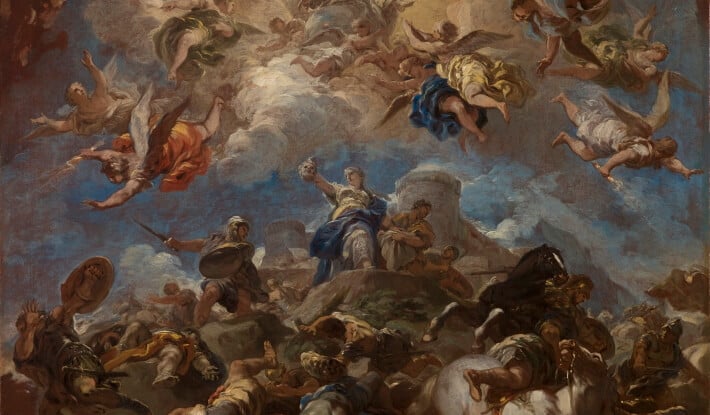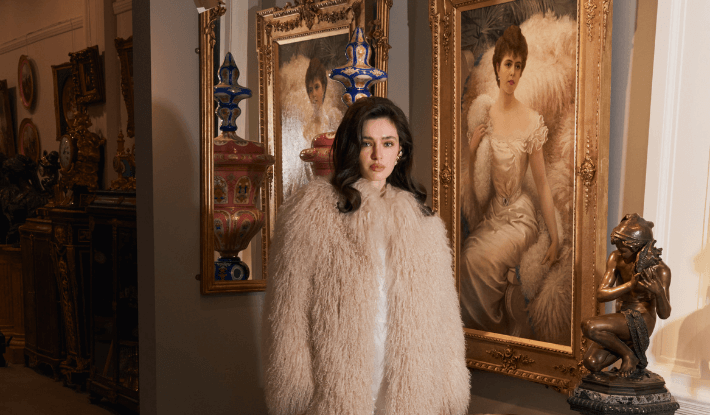The city of Bethulia has been ravaged by the Assyrian King, Holofernes. With all hope lost, a young Bethulian woman named Judith approaches the King’s encampment, determined to free her city. She greets this fearsome leader, adorned in her best robes and with a false wish to forge an alliance. Holofernes is enamoured. He invites Judith to stay and, after feasting and drinking, he falls asleep. In the silence of the night, Judith unsheathes her sword and decapitates the King.
This dramatic and gruesome moment originates from the biblical text the ‘Book of Judith’. The legend of Judith and Holofernes has inspired various iterations by master painters and is the subject of an exquisite recent acquisition at Mayfair Gallery, currently hanging at the entrance to our main gallery space on South Audley Street. This blog looks at this supremely crafted work, exquisite in colour and detailing, and considers how the artist has conveyed the biblical scene, compared to other artistic greats including Caravaggio and Artemisia Gentileschi.
Mayfair Gallery's large antique KPM porcelain plaque of 'Judith', after Riedel
Designed after August Riedel’s painting from 1840, this plaque faithfully renders the original within a carved giltwood frame with a red velvet backing.
The plaque, specially crafted by the Royal porcelain makers of Berlin, KPM (Konigliche Porzellan-Manufaktur), depicts Judith’s victory.
If you lean towards her, you’ll notice she is holding something in her right hand. Just behind her body, she grasps the head of Holofernes. Judith looks beyond us: regal, victorious, avenged.
'Judith', after Riedel, as found in Mayfair Gallery.
This story reverberates through the halls of fine art fame. Renaissance, Baroque, and Modern painters have retold this story, reconstructing Judith’s identity throughout the ages.
The Renaissance Judith: Femme Fatale
In the Renaissance, painters often departed from the early Christian portrayal of Judith as demure and virginal. Instead, Judith was sexualised, a femme fatale.
This is notable in Italian painter, Giorgione’s ‘Judith’ from 1504. Judith is half-robed in a pink dress, her bare foot resting upon Holofernes’ head.
Critic, Renate Peters, notes that ‘the one bare leg appearing through a special slit in the dress evokes eroticism, indicates ambiguity and is thus a first allusion to Judith’s future reversals from Mary to Eve’ (2001).
The Baroque Judith: Gruesome Yet Timid
Judith’s identity is malleable, however, and, by the Baroque period, she changes once again.
Depictions of Judith and Holofernes become more gruesome, foregrounding violence and gore.
In 1602, Italian painter, Caravaggio, recreated ‘Judith Beheading Holofernes’ in his work by the same name.
In Caravaggio’s piece, we meet Judith in the middle of the execution.
She is attempting to behead Holofernes who emerges, writhing, from the rich darkness of ruby and emerald garments, as if illuminated by Judith’s crisp white shirt.
Our heroine, however, appears unsure, timid even, as she appears to pull away from the beheading, reticent to continue with the very act that will make her heroic.
This late 16th-century rendition by Caravaggio depicts the gruesome nature of the beheading.
Caravaggio Versus Gentileschi
Artemisia Gentileschi, another Baroque painter, challenges Caravaggio’s portrayal through her presentation of Judith in her work, ‘Judith Slaying Holofernes’ (1614-1620).
Gentileschi’s Judith is more assured. She stands over Holofernes, driving the sword into his neck with her sleeves rolled above her elbows.
This comparison was a key component of Breach Theatre company’s 2020 production, ‘It’s True, It’s True, It’s True’. This show compared Gentileschi and Caravaggio’s depictions of Judith, specifically focussing on the autobiographical influence in Gentileschi’s work.
In 1611, three years before Artemisia Gentileschi began this painting of Judith, she was embroiled in a rape trial against Agostino Tassi, an Italian landscape and seascape painter. This trial is the premise of Breach Theatre’s ‘It’s True’ and posits that Judith is a vessel through which Gentileschi explores her own rage.
The National Gallery considered this autobiographical lens in their 2020 exhibition, ‘Artemisia’. The Gallery explains, ‘Artemisia painted subjects that were traditionally the preserve of male artists and for the male gaze; transforming meek maidservants into courageous conspirators and victims into survivors’.
Breach Theatre similarly notes the gendered difference between Caravaggio and Gentileschi’s Judith:
“Caravaggio’s Judith is so meek. She’s got these stick thin arms and she looks like she’s regretting it before she’s even got started.”
Gentileschi’s work, however, showcases a woman fuelled by revenge. Gentileschi’s Judith is not scared of the sight in front of her, nor is she a traditionally demure representation of the biblical heroine. Gentileschi thus presents her own Judith, fuelled by a rage that will echo from the 17th century into the 21st.
Artemisia Gentileschi's portrayl of Judith and Holofernes has sparked artistic and theatrical intrigue in recent years.
The Modern Judith: Contemporary Conflict
As we move into the 2010s, we discover a racialised retelling of the legend.
In 2012, New York based artist Kehinde Wiley exhibited his latest work, ‘Judith and Holofernes’. Wiley’s canvas presents Judith, a Black woman, wielding the head of Holofernes or, more specifically, the head of a white woman.
Wiley explores the racial power dynamic between the two women. In the 21st century, this biblical legend takes on a socio-political statement against the forces of white supremacy.
The story of Judith and Holofernes is thus one which can be reinvented, continuously changing with artistic and activist conversation.
Judith Inside Mayfair Gallery
We return then to the plaque that hangs in Mayfair Gallery. With the head of Holofernes by her side, Judith looks past us. In her left hand, she holds the sword which canonises her in biblical and artistic legend, a muse for artists to explore revenge, gender, and power. Riedel’s colours are striking.
Unlike Gentileschi and Caravaggio’s bloody works, the only red upon the plaque is woven into Judith’s robes. She is adorned in red, gold, and purple.
Instead of witnessing the beheading, we are invited to glory in her victory, Holofernes quite literally behind her.
As we look upon this plaque, we see the iterations of the biblical heroine that speak to audiences today, a symbol of the woman who cries, ‘it’s true, it’s true, it’s true’
Mayfair Gallery’s KPM Porcelain Plaque of ‘Judith’ is available to purchase. For further details and to make an enquiry, please visit: mayfairgallery.com/judith-large-antique-kpm-porcelain-plaque-after-riedel










